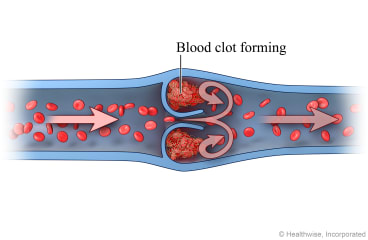What is a vena cava filter?

A vena cava filter may help prevent blood clots from traveling from your lower limbs to your lungs. The clots may block blood flow in the lungs. A clot that travels to the lungs may cause serious problems or even death.
The filter is shaped like an umbrella. It is placed in the large vein that returns blood to the heart from the belly and legs. This vein is called the inferior vena cava.
Your doctor inserts a thin, flexible tube called a catheter through a vein in your neck or groin and then into the vena cava. Next, the doctor uses the catheter to place the filter. The filter may be permanent or may be removed later.
Vena cava filters may be used if you can't take a medicine (called a blood thinner) that prevents blood clots.
How do you prepare for the procedure?
Procedures can be stressful. This information will help you understand what you can expect. And it will help you safely prepare for your procedure.
Preparing for the procedure
- Understand exactly what procedure is planned, along with the risks, benefits, and other options.
- Tell your doctor ALL the medicines, vitamins, supplements, and herbal remedies you take. Some may increase the risk of problems during your procedure. Your doctor will tell you if you should stop taking any of them before the procedure and how soon to do it.
- If you take aspirin or some other blood thinner, ask your doctor if you should stop taking it before your surgery. Make sure that you understand exactly what your doctor wants you to do. These medicines increase the risk of bleeding.
- Be sure to tell your doctor about any allergies you have, especially to anesthesia or contrast materials.
- Make sure your doctor and the hospital have a copy of your advance directive. If you don’t have one, you may want to prepare one. It lets others know your health care wishes. It’s a good thing to have before any type of surgery or procedure.
- Be sure you have someone to take you home. Anesthesia and pain medicine will make it unsafe for you to drive or get home on your own.
What happens on the day of the procedure?
- Follow the instructions exactly about when to stop eating and drinking. If you don't, your procedure may be canceled. If your doctor told you to take your medicines on the day of the procedure, take them with only a sip of water.
- Follow your doctor's instructions about when to bathe or shower before your procedure. Do not apply lotions, perfumes, deodorants, or nail polish.
- Take off all jewelry and piercings. And take out contact lenses, if you wear them.
At the hospital or surgery center
- Bring a picture ID.
- You will be kept comfortable and safe by your anesthesia provider. You may get medicine that relaxes you or puts you in a light sleep. The area being worked on will be numb.
- After the procedure, pressure may be applied to the area where the catheter was put in your blood vessel. This will help prevent bleeding. A small device may also be used to close the blood vessel. The area may be covered with a bandage or a compression device.
- Nurses will check your heart rate and blood pressure. The nurse will also check the catheter site for bleeding.
- If the catheter was put in your groin, you will need to lie still and keep your leg straight for up to a few hours. The nurse may put a weighted bag on your leg to help you keep it still and prevent bleeding.
- You may have a bruise or a small lump where the catheter was put in your blood vessel. This is normal and will go away.
Current as of: July 31, 2024
Author: Ignite Healthwise, LLC Staff
Clinical Review Board
All Ignite Healthwise, LLC education is reviewed by a team that includes physicians, nurses, advanced practitioners, registered dieticians, and other healthcare professionals.

